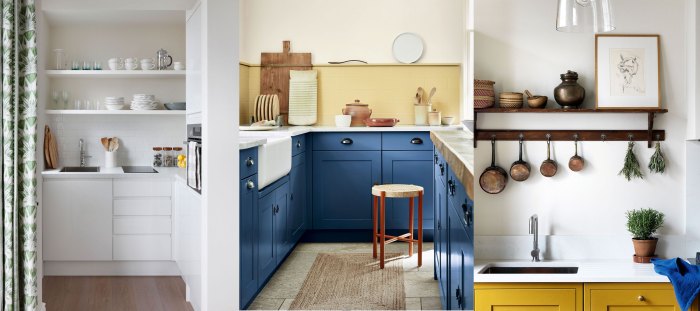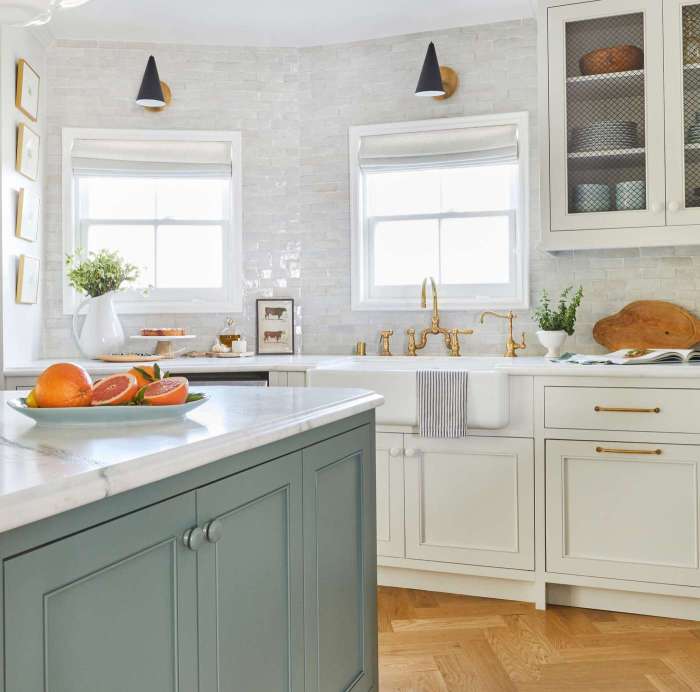Space Optimization Techniques for Small Kitchens
Decorating small kitchen – Maximizing space in a small kitchen requires careful planning and the implementation of clever storage solutions. Efficient layouts and the strategic use of vertical space are key to achieving a functional and aesthetically pleasing kitchen, even within limited square footage.
Small Kitchen Layouts and Counter Space
The layout of a small kitchen significantly impacts its functionality and perceived spaciousness. Consider these common layouts and their impact on counter space and storage:
| Layout | Counter Space | Storage | Pros |
|---|---|---|---|
| Galley | Moderate; often linear | Can be high with wall cabinets | Efficient use of space, good workflow |
| L-Shaped | Good; two adjacent walls provide ample counter space | Good; can incorporate corner cabinets | Versatile, allows for an island or peninsula in larger spaces |
| U-Shaped | Excellent; three walls provide maximum counter space | Excellent; ample wall cabinet space | Highly functional but requires sufficient space |
| One-Wall | Limited; all counters on one wall | Moderate; wall cabinets and potentially under-counter storage | Suitable for very small kitchens |
Clever Storage Solutions for Small Kitchens
Smart storage solutions are crucial for keeping a small kitchen organized and clutter-free. Consider these options:
- Pull-out shelves and drawers: Maximize access to items in deep cabinets.
- Vertical dividers and organizers: Keep items separated and easily accessible within drawers and shelves.
- Over-the-door organizers: Utilize often-wasted space on cabinet doors.
- Under-sink organizers: Optimize space under the sink with tiered shelves and caddies.
- Magnetic strips: For knives, utensils, and other metal items.
- Wall-mounted racks: For spices, pans, and other frequently used items.
Utilizing Vertical Space in Small Kitchen Design
Vertical space is often underutilized in small kitchens. By strategically incorporating tall cabinets and open shelving, you can significantly increase storage capacity without sacrificing valuable floor space. Consider open shelving for displaying attractive dishes or frequently used items, while utilizing taller cabinets for less frequently used items.
Examples include installing open shelving above the countertop, using tall, narrow cabinets to fill corner spaces, and incorporating a built-in pantry that extends to the ceiling.
Decluttering and Organizing Small Kitchen Items
Regular decluttering and organization are essential for maintaining a functional and aesthetically pleasing small kitchen. This involves regularly purging unused or expired items, and implementing a system for storing items efficiently.
Tips include regularly reviewing pantry and refrigerator contents, using clear containers for storage to easily see contents, and designating specific storage areas for different types of items.
Color Schemes and Lighting for Small Kitchens
Color palettes and lighting significantly impact the perceived size and ambiance of a small kitchen. Light, bright colors and strategic lighting can create an illusion of spaciousness, while thoughtful color choices can enhance the overall aesthetic.
Right, so you’re tryna sort your gaff out, innit? Decorating a tiny kitchen’s a proper faff, but check it – if you’re looking for somewhere to unleash your inner interior designer, maybe have a gander at this: house for rent by owner near me. Finding the right place is half the battle, then you can get cracking on those cute shelves and splashback ideas.
Sorted!
Color Palettes for Small Kitchens
The following color palettes are suitable for small kitchens, each offering a different effect on the perceived size of the space:
Palette 1: Bright and Airy – White, light gray, and pastel blue create a clean, spacious feel. The light colors reflect light, making the room feel larger. Example: White cabinets, light gray walls, and pastel blue accents.
Palette 2: Warm and Inviting – Cream, beige, and warm wood tones create a cozy and welcoming atmosphere. While not as expansive as light colors, they still offer a sense of openness. Example: Cream cabinets, beige walls, and warm wood countertops.
Palette 3: Monochromatic Elegance – Different shades of a single color, such as gray or blue, can create a sophisticated and calming effect. Varying shades helps to add visual interest without overwhelming the space. Example: Dark gray lower cabinets, medium gray walls, and light gray upper cabinets.
Right, so you’re tryna sort your gaff out, decorating a tiny kitchen’s a proper mission, innit? Finding space-saving ideas is key, especially if you’re on a budget – like, if you’re checking out cheap house for rent places, you’ll probably need to be savvy. But don’t stress, you can still make it look lush with a few clever tricks; think clever storage and bright colours to make it feel bigger.
Impact of Natural and Artificial Lighting
Natural light brightens and expands the feeling of a small kitchen. Artificial lighting should complement this, providing adequate task lighting for food preparation and ambient lighting for a warm atmosphere.
| Lighting Type | Pros | Cons | Best Use |
|---|---|---|---|
| Recessed Lighting | Even illumination, energy-efficient | Can be harsh without diffusers | General ambient lighting |
| Under-Cabinet Lighting | Excellent task lighting, illuminates countertops | Can be expensive to install | Food preparation areas |
| Pendant Lights | Stylish, adds visual interest | Can take up valuable headroom | Focal point above an island or peninsula |
| Track Lighting | Versatile, adjustable | Can be visually overwhelming in small spaces | Highlight specific areas |
Small Kitchen Lighting Plan
A well-designed lighting plan combines ambient, task, and accent lighting. Ambient lighting provides overall illumination, task lighting illuminates work areas, and accent lighting highlights specific features. Example: Recessed lighting for overall illumination, under-cabinet lighting for task lighting, and pendant lights over an island for accent lighting.
Strategic Use of Mirrors
Mirrors strategically placed can visually expand a small kitchen. A large mirror on one wall can reflect light and create the illusion of more space. Avoid placing mirrors opposite windows, as this can create glare.
Choosing Appliances and Furniture for Small Kitchens
Selecting the right appliances and furniture is crucial for maximizing functionality and minimizing clutter in a small kitchen. Multi-functional pieces and compact appliances are essential for making the most of limited space.
Small Kitchen Appliances: Comparison
| Appliance | Pros | Cons | Space Saving Tip |
|---|---|---|---|
| Compact Refrigerator | Saves space, energy-efficient | Less storage capacity | Choose a model with adjustable shelves |
| Multi-Cooker (Instant Pot, etc.) | Combines multiple functions (slow cooker, pressure cooker, etc.) | Can be bulky | Store it in a cabinet when not in use |
| Compact Dishwasher | Saves space, convenient | Smaller capacity than standard dishwashers | Consider a portable model if space is extremely limited |
| Microwave Oven (Over-the-range or Countertop) | Essential for quick reheating | Can take up counter space | Choose an over-the-range model to free up counter space |
Space-Saving Furniture Options
Foldable tables and chairs are ideal for small kitchens, as they can be easily stored away when not in use. Consider a drop-leaf table or a wall-mounted folding table.
Multi-Functional Furniture
- Island with storage: Provides extra counter space and storage.
- Cabinet with built-in cutting board: Combines storage and prep space.
- Bench seating with storage: Offers seating and storage for kitchen items.
Appliance and Furniture Selection

Source: futurecdn.net
Selecting appliances and furniture should align with the kitchen layout and personal needs. Prioritize essential appliances and furniture that meet your cooking and storage needs, and choose compact models to save space. Measure your space carefully before purchasing any items.
Decorative Elements and Style for Small Kitchens: Decorating Small Kitchen
Decorating a small kitchen involves carefully selecting elements that enhance the space without overwhelming it. A minimalist approach, using a limited color palette and carefully chosen decorative items, is often most effective.
Minimalist Small Kitchen Design
A minimalist kitchen features clean lines, a neutral color palette, and a focus on functionality. Example: White or light gray cabinets, a simple backsplash, minimal countertop clutter, and a few carefully chosen decorative elements such as a small vase of flowers or a piece of minimalist wall art.
Suitable Decorative Elements
- Wall art: Choose small-scale art that complements the overall style.
- Plants: Add life and vibrancy, but avoid overcrowding the space.
- Textiles: Use small, tasteful textiles such as a simple runner or placemats.
- Open shelving with decorative items: Display attractive dishes or cookbooks.
Use of Textures and Patterns
Textures and patterns can add visual interest to a small kitchen without overwhelming the space. Use subtle textures and patterns in small doses, such as a patterned backsplash or textured countertop.
Incorporating Personal Touches

Source: thespruce.com
Personal touches create a cozy and welcoming atmosphere. Incorporate items that reflect your personality and style, such as family photos, favorite cookbooks, or small decorative items.
Budget-Friendly Decorating Ideas for Small Kitchens
Decorating a small kitchen on a budget is achievable with creative ideas and smart shopping. DIY projects, repurposing items, and choosing cost-effective materials can help you create a visually appealing kitchen without breaking the bank.
Affordable Decorating Ideas
- DIY projects: Paint cabinets, update hardware, create a custom backsplash using tile or other materials.
- Repurposing items: Use old jars as storage containers, repurpose vintage trays as wall decor.
- Shop sales and clearance items: Look for deals on kitchen accessories and decor.
- Use inexpensive materials: Consider using affordable materials such as contact paper for cabinet refacing.
Cost-Effective Materials and Methods
| Item | Cost-Effective Material | Method | Estimated Cost |
|---|---|---|---|
| Cabinet Refacing | Contact paper or paint | DIY | $50-$150 |
| Backsplash | Peel-and-stick tiles or paint | DIY | $30-$100 |
| Countertops | Laminate | Professional installation | $500-$1500 |
| Hardware | Affordable knobs and pulls | DIY | $20-$50 |
Prioritizing Purchases, Decorating small kitchen
Prioritize purchases based on their impact on the overall look and functionality of the kitchen. Focus on items that will make the biggest difference, such as painting cabinets or updating hardware.
Finding Affordable Kitchen Accessories
Thrift stores, flea markets, and online marketplaces are great places to find affordable yet stylish kitchen accessories.
Questions Often Asked
Can I use dark colors in a small kitchen?
Yes, but strategically. Dark colors can create a cozy atmosphere, but use them on accent walls or in specific areas, balancing them with lighter colors and ample lighting to avoid making the space feel cramped.
How do I deal with limited counter space?
Maximize vertical space with shelves and wall-mounted organizers. Consider retractable or fold-down countertops or islands to add workspace only when needed.
What are some inexpensive ways to update my small kitchen?
Repainting cabinets, adding new hardware, and incorporating inexpensive textiles like rugs and curtains can significantly impact the look and feel of your kitchen without breaking the bank.
How important is lighting in a small kitchen?
Crucial. Good lighting brightens the space, making it feel larger. Combine ambient, task, and accent lighting for a layered and effective approach. Consider under-cabinet lighting and track lighting for optimal illumination.
 Interior Living
Interior Living
